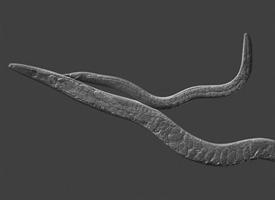Choosing between two good things can be tough. When animals must decide between feeding and mating, it can get even trickier. In a discovery that might ring true even for some humans, researchers have shown that male brains – at least in nematodes – will suppress the ability to locate food in order to instead focus on finding a mate.
The results, which appear today in the journal Current Biology, may point to how subtle changes in the brain’s circuitry dictate differences in behavior between males and females.
“While we know that human behavior is influenced by numerous factors, including cultural and social norms, these findings point to basic biological mechanisms that may not only help explain some differences in behavior between males and females, but why different sexes may be more susceptible to certain neurological disorders,” said Douglas Portman, Ph.D., an associate professor in the Department of Biomedical Genetics and Center for Neural Development and Disease at the University of Rochester and lead author of the study.
The findings were made in experiments involving C. elegans, a microscopic roundworm that has long been used by researchers to understand fundamental mechanisms in biology. Many of the discoveries made using C. elegans apply throughout the animal kingdom and this research has led to a broader understanding of human biology. In fact, three Nobel Prizes in medicine and chemistry have been awarded for discoveries involving C. elegans.
C. elegans is particularly useful in the study of the nervous system and scientists understand in great detail the development, function, and multiple connections of its entire neural network.
The study published today focuses on the activity of a single pair of neurons found in C. elegans – called AWA – that control smell. Smell, along with taste and touch, are critical sensory factors that dictate how C. elegans understands and navigates its environment, including finding food, avoiding danger, and locating a mate.
There are two sexes of C. elegans, males and hermaphrodites. Though the hermaphrodites are able to self-fertilize, they are also mating partners for males, and are considered to be modified females.
It has been previously observed that males and hermaphrodites act differently when exposed to food. If placed at a food source, the hermaphrodites tend to stay there. Males, however, will leave food source and “wander” – scientist believe they do this because they are in search of a mate.
The Rochester researchers discovered that the sensory mechanisms – called chemoreceptors – of the AWA neurons were regulated by the sexual identity of these cells, which, in turn, controls the expression of a receptor called ODR-10. These receptors bind to a chemical scent that is given off by food and other substances.
In hermaphrodites, more of the ODR-10 receptors are produced, making the worms more sensitive – and thereby attracted – to the presence of food. In males, fewer of these receptors are active, essentially suppressing their ability – and perhaps desire – to find food. However, when males were deprived of food, they produced dramatically higher levels of this receptor, allowing them to temporarily focus on finding food.
To confirm the role of these genetic differences between the sexes on behavior, the researchers designed a series of experiments in which they observed the activity of C. elegans when placed in a petri-dish and confronted with the option to either feed or go in search of a mate. The hermaphrodites were place in the center of the dish at a food source and, as expected, they stayed put.
The males were placed in their own individual food sources at the periphery of the dish. As a further obstacle between the males and their potential mates, an additional ring of food surrounded the hermaphrodites in the center of the dish. The males in the experiment consisted of two categories, one group with a normal genetic profile and another group that had been engineered by the researchers to overexpress the ODR-10 receptor, essentially making them more sensitive to the smell of food.
The researchers found that the normal worms left their food source and eventually made their way to the center of the dish where they mated with the hermaphrodites. The genetically engineered males were less successful at finding a mate, presumably because they were more interested in feeding. By examining the genetic profile of the resulting offspring, the scientists observed that the normal males out-produced the genetically engineered males by 10 to one.
In separate experiments, the researchers were also able to modify the behavior of the hermaphrodites by suppressing the ODR-10 receptors, causing them to act like males and abandon their food source.
“These findings show that by tuning the properties of a single cell, we can change behavior,” said Portman. “This adds to a growing body of evidence that sex-specific regulation of gene expression may play an important role in neural plasticity and, consequently, influence differences in behaviors – and in disease susceptibility – between the sexes.”
Additional authors include Deborah Ryan, Renee Miller, KyungHwa Lee, and Kelli Fagan with the University of Rochester, and Scott Neal and Piali Sengupta with Brandeis University. The research was supported by funding from the National Institute of General Medical Sciences, the National Science Foundation, the Human Frontiers Science Program, and the National Alliance for Autism Research /Autism Speaks.

